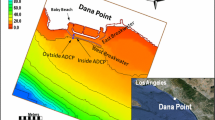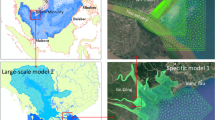Abstract
A surface wave modeling was applied on the right margin of Sergio Motta Dam Reservoir (Porto Primavera Dam), Brazil, to investigate the behavior of breakwaters against impact of incoming waves. The Simulating WAves Nearshore (SWAN) spectral wave model was applied to simulate waves generated by wind in the reservoir. Between 2009 and 2012 researchers from the Brazilian Institute of Technological Research (IPT) conducted several studies and developed an experimental project to protect reservoir banks from erosion caused by waves. Three different kinds of submerged breakwaters were installed in 2009, 1.0 km along the shoreline, in five stretches of 100 m length each, with an interval of 100 m between them. Two breakwaters were made of concrete (with an innovative arrangement) and the third one was made from geotextile tubes. The objective of the study was to compare and validate the modeling results with those observed in situ. Different simulations were done: 1—for the same arrangements of breakwaters installed on a segment in the reservoir, 2—for each structure, with a single side-by-side arrangement. The results indicate that the structures reduce wave heights by 35–40% compared to no breakwater. The single side-by-side structure arrangement showed better performance results when compared to the original in situ configuration installed. Wave height attenuation was found to be highly dependent on the incident wave direction relative to breakwater orientation, and even considering a single structure configuration, the differences in performance depends on the wind direction and speed relative to the structure position.
Access provided by Autonomous University of Puebla. Download conference paper PDF
Similar content being viewed by others
Keywords
1 Introduction
Erosion of reservoir banks involves a complex relationship of processes that contribute to the occurrence of different problems related to physical issues directly in the affected areas, as well as social ones, such as the impacts on the activities resulting from human occupation. The main agents of erosion are the wave’s action, the surface runoff and the elevation of the water level (aquifer). Among these agents, the wave represent the most devastating erosive process and occurs mainly in large reservoirs, whose extensive surface area presents significant and propitious fetches to the generation of these waves.
In this work, the Simulating WAves Nearshore (SWAN) spectral wave model was applied on the right margin of Sergio Motta Dam Reservoir (Porto Primavera Dam), Brazil, to simulate waves generated by wind in the reservoir lake.
2 Study Area and Objectives
The Sergio Motta Dam Reservoir (Porto Primavera Dam) is located half way down the Paraná River, on the borders of the states of São Paulo and Mato Grosso do Sul, in Brazil, downstream of the Jupiá dam and upstream of the Itaipu dam (Fig. 1). The drainage area of the basin is 574,000 km2; the reservoir surface and capacity are 2044 km2 and 15.7 km3 respectively (Celeri et al. 2005).
Between 2009 and 2012 researchers from Brazilian Institute of Technological Research (IPT 2012) conducted several studies and developed an experimental project to protect banks from erosion caused by waves in the reservoir. Three different kinds of submerged breakwaters were installed in 2009, 1.0 km along the shoreline, in five stretches of 100 m length each and with an interval of 100 m between them (Fig. 2).
The objective of this study is to compare the surface wave modeling results with the performance of the breakwaters installed in the experimental area on the right reservoir margin (IPT 2012) and verify the behavior of the structures in a single side-by-side arrangement.
3 Materials and Methods
3.1 Model Set-Up
The grid implemented in the studied area was generated from the physical contours of the preexisting cartographic base (level contours and reservoir margin line). The grid was built using RFGRID tool of the Delft3D software package. Around the area of the submerged breakwaters the grid is more detailed (presents a higher resolution) in order to enable better representation of the structures. The breakwaters were reproduced in the model exactly in the same position and arrangement installed, according to the sonographic survey images, obtained in 2012. The final grid shows 12,389 cells, with horizontal resolution of 66 × 199 cells.
Bathymetry survey data collected in 2012 were projected onto the model grid using triangular interpolation of the survey points using the QUICKIN tool. The grid and bathymetry of the model are shown in Figs. 3 and 4. Two breakwaters were composed of concrete and the third one of geotextile tubes.
The installation arrangements were: breakwaters, side by side, aligned in a single line for geotextile tubes and aligned in multiple lines for the breakwaters made of concrete. All breakwaters were submerged (water column of 0.80 m). The wave parameters were measured in the reservoir previously and the values adopted for the upstream dam model were the same as those specified for the experimental erosion control project, i.e. a 1.5 m wave height, with a period of 5 s. The wind speed used was 10 and 20 m/s with an incidence direction of 180°, considering the true South.
The structures were represented as Dam type obstacles. In this option, the model admits that the transmission coefficient depends on the condition of the wave incident on the obstacle as well as its height. The values used for the transmission coefficients α and β (used in the mathematical formulation when processing the modeling) were 1.8 and 0.1, respectively.
Wave simulations were performed for three scenarios: 1—margin without breakwater to obtain the initial wave condition in the studied section; 2—the same arrangements of breakwaters installed on a segment in the reservoir and 3—different arrangement from the original installed, with simulations for each structure, aligned side-by-side.
4 Results and Discussion
The simulation for scenario 1 considered significant wave heights (Hsig) varying between 0.8 and 1.3 m in the studied area, without structures. Scenario 2 represents the situation after the installation of the breakwaters and the wave heights were reduced to values between 0.6 and 0.8 m and 0.7 and 0.85 m; the winds velocities considered were 10 and 20 m/s, respectively (Fig. 5).
The geotextile tube and pyramidal with multiple lines structures showed the best performance in reducing the significant wave height, with rates of 42%.
Some points were chosen in the numerical grid to measure the values of significant wave heights after the breakwaters for the scenario 2 simulation. The values are show in Table 1.
The simulations for scenario 3 considered a different arrangement from the original installed. Only one structure was simulated at a time, repeated side by side in the same extension area.
The significant wave height reduction was evaluated in sections behind the breakwater (considering a grid cell behind the breakwater inside the final grid).
The results show that all the breakwaters, even individually, have reduced the significant wave heights from 1.2 m to values between 0.6 and 0.8 m (Fig. 6 and Table 2).
Significant wave height reduction considering the breakwaters for scenario 3 simulations (wind speed of the 10 m/s). Breakwaters: a sinuous concrete in multiple lines and in a single line; b pyramidal concrete in multiple lines and in a single line; c geotextile. Values displayed on the scale (0.0–0.6 m) show how much the incident wave height has been reduced after the breakwater (difference between the scenarios with and without breakwaters)
5 Final Considerations
The Simulating WAves Nearshore (SWAN) spectral wave model was applied to simulate waves generated by wind in the reservoir lake of Porto Primavera, Brazil. The results obtained with this study were satisfactory and show the model efficiency in this sort of study. The more significant wave height (m) reductions were obtained whit the geotextile tube and the pyramidal concrete breakwaters (42% of reduction). These results are similar to those verified in the breakwaters installed in reservoir margin and in the hydrodynamic laboratory tests performed at the Institute for Technological Research (Instituto de Pesquisas Tecnológicas—IPT).
Each breakwater has a specific configuration, with different shapes and sizes. When installed side-by-side their performance in response to incoming waves may be adversely affected by their structural differences and different wave incident directions. Simulations for only one type of breakwater, aligned, at first, exhibited better performance when compared to the original configuration installed (different types side-by-side) in the reservoir margin. Even in the individual configuration, differences in performance are observed in the reduction of significant wave height, because the structures are submitted to different wave spectra, with different energies. Breakwaters simulations are recommended prior the implementation in the reservoirs should be considered as an alternative, as it assists in the best planning and management of the work that will be performed, and thus also minimizing costs.
References
Celeri, A., Alves, C.F.C., Carvalho, N.O.: Study of Protection alternatives for the control of erosion in the margins of Sergio Motta dam. Technical Report nº 130 968-205, Sao Paulo, Brazil (2005) (in Portuguese)
Institute for Technological Research.: Study of protection alternatives for the control of erosion on the margins of the Sergio Motta dam (Porto Primavera). Technical Report 130 968–205. Research and Development Funding CESP/Brazilian Electric Power Agency—ANEEL (2012) (in Portuguese)
Author information
Authors and Affiliations
Corresponding authors
Editor information
Editors and Affiliations
Rights and permissions
Copyright information
© 2019 Springer Nature Switzerland AG
About this paper
Cite this paper
Siqueira, A.G., Fiedler, M.F.M., Yassuda, E.A., Sousa, L.A.P. (2019). Wave Modeling and Coastal Erosion in Upstream Dams. In: Shakoor, A., Cato, K. (eds) IAEG/AEG Annual Meeting Proceedings, San Francisco, California, 2018 - Volume 4. Springer, Cham. https://doi.org/10.1007/978-3-319-93133-3_2
Download citation
DOI: https://doi.org/10.1007/978-3-319-93133-3_2
Published:
Publisher Name: Springer, Cham
Print ISBN: 978-3-319-93132-6
Online ISBN: 978-3-319-93133-3
eBook Packages: Earth and Environmental ScienceEarth and Environmental Science (R0)










